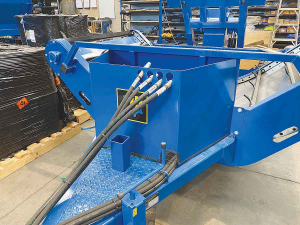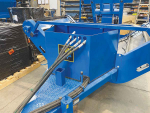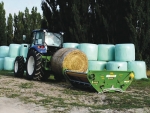You don't have to travel very far to find a farm using McIntosh feeding equipment, and those doing so report a robust construction, clever engineering and a long working life.
The Double Bale Feeder builds on this reputation and offering the ability to deal with round or square bales.
The chassis consists of two box sections running through the bale cradle to increase overall strength, while the layout also lowers the overall loading height and centre of gravity, to promote safe use on hillsides or sloping ground.
A 315mm overhang on the discharge elevator, combined with tyres kept close to the chassis means that delivered feed is not “run over” and contaminated, while a choice of wheel settings allows safer operation on difficult terrain or the option of fitting larger tyres. As standard, machines are supplied with 11.5 x 15.3 tyres, a detail that helps to reduce rolling resistance, making towing easier in poor conditions.
An over-dimensioned lifting arm can deal with the heaviest bales, while also being able to carry a second bale to the feeding area. The design features twin lift rams which gently lower the bale onto the unrolling cradle and helps prevent damage to the feeder bars. The unrolling cradle uses a zinc-plated, 12,000 lb rated chain, with slow running shafts utilising bronze bushes for resistance to silage juice, and a greater service life. Unloading slats are manufactured from 8mm steel with integral teeth to promote bale rotation by increasing the contact area, while in the cradle aggression pins restrict bale movement to encourage the teeth to pull the bale apart.
From a practical point of view the machine includes a rubbish bin, and a chequer-plated platform on the drawbar a-frame to allow the user to safely remove the film and net wrap.
Since its introduction, the manufacturer has introduced several options and redesigns to make using the feeders easier.
On the rear lifting forks, these include a third, central tine, set lower and said to be useful for dealing with soft or mis-shaped bales.
For those handling square bales, lateral extensions, each carrying an extra tine, ensure positive lifting onto the cradle, while those dealing with chop bales can specify front and rear infill panels to stop material being lost before it heads up the discharge conveyor.
In addition to the lateral extensions, those feeding squares might also option the machine with optional siderails for the bale cradle. All machines now include a larger, waste box.













